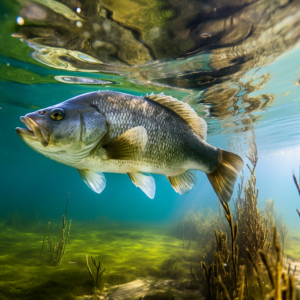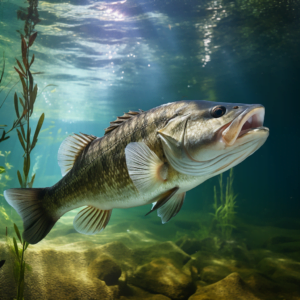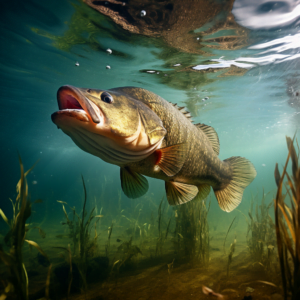Have you ever wondered how long a bass can live? Well, let’s dive into this fascinating topic and explore the lifespan of bass. Whether you’re an avid angler or simply curious about the world of fish, understanding their lifespan can give you valuable insights into their biology and behavior.
Bass, which refers to various species of freshwater fish, can live for quite a significant amount of time. On average, a bass can live anywhere between 10 to 20 years, depending on various factors such as environmental conditions and predation. However, some exceptional individuals have been known to live even longer, with reports of bass reaching over 25 years of age!
To fully comprehend the lifespan of bass, it’s essential to consider the different species within the bass family. The most common species, the largemouth bass, has an average lifespan of around 10 to 15 years. On the other hand, smallmouth bass tend to have a slightly shorter lifespan, ranging from 8 to 12 years. Nevertheless, these are just general estimates, and individual fish can vary greatly in their longevity.
If you’re interested in learning more about the lifespan of bass and the factors that influence it, keep reading our article. We’ll explore the impact of habitat, diet, genetics, and fishing practices on the lifespan of bass, providing you with a comprehensive understanding of these fascinating creatures. So, whether you’re planning your next fishing expedition or simply enjoy learning about aquatic life, buckle up and get ready for an insightful journey into the world of bass.
Understanding the Lifespan of Bass
Bass, a popular sport fish, are known for their size, strength, and fight. Anglers from all over the world seek out bass for their exhilarating fishing experiences. But have you ever wondered how long bass actually live? In this article, we will delve deeper into the lifespan of bass, exploring the key factors affecting their lifespan, their natural lifespan, their longevity in different environments, the impact of habitat quality, diet and nutrition, reproduction and reproductive lifespan, predators and survival, human impact, and the importance of bass lifespan research and studies. So, let’s dive in and understand the lifespan of bass!
Key Factors Affecting Bass Lifespan
Various factors contribute to the lifespan of bass, including genetic, environmental, ecological, and human-induced factors.
Genetic Factors
Genetics play a significant role in determining the lifespan of bass. Different subspecies and populations of bass may exhibit variations in their lifespan due to genetic differences. Some individuals may be genetically predisposed to live longer, while others may have shorter lifespans.
Environmental Factors
The environment in which bass live has a profound impact on their lifespan. Factors such as water temperature, water quality, availability of food, and the presence of predators can all influence bass longevity. Bass are adaptable fish, and their lifespan can be affected by the conditions they encounter throughout their lives.
Ecological Factors
The ecological dynamics of the bass’s habitat also play a role in determining their lifespan. The presence of suitable spawning areas, the availability of prey, and the overall ecosystem health can have significant implications for bass longevity. A well-balanced and healthy ecosystem supports the natural lifespan of bass.
Human-Induced Factors
Human activities can have both positive and negative impacts on bass lifespan. Fishing practices, pollution and contamination in water bodies, and habitat destruction and alteration can all contribute to the reduction of bass lifespan. Responsible management and conservation efforts are crucial in preserving the lifespan of bass.
Natural Lifespan of Bass
To understand the natural lifespan of bass, it is important to explore their life stages, survival rates, and mortality factors.
Overview of Bass Lifespan in the Wild
In the wild, bass typically have a lifespan ranging from 10 to 16 years, depending on various factors. The largemouth bass, one of the most popular bass species, tends to have a longer lifespan compared to other bass species.
Life Stages of Bass
Bass go through several life stages, starting as eggs, hatching into fry, growing into juveniles, and eventually reaching adulthood. Each life stage comes with its own set of challenges and mortality risks.
Survival Rates and Mortality Factors
Survival rates during the early stages of bass life are often low, with a considerable number of eggs and fry falling victim to predation or natural causes. However, as they grow older and reach maturity, survival rates improve. Predation, disease, environmental fluctuations, and competition for resources are among the mortality factors that can impact the lifespan of bass.
Bass Longevity in Different Environments
Bass are found in various bodies of water, including freshwater and saltwater environments. Let’s explore how their longevity differs in these different habitats.
Freshwater Bass Longevity
In freshwater environments, such as lakes, rivers, and reservoirs, bass generally have a longer lifespan compared to their saltwater counterparts. The stable and more controlled conditions of freshwater habitats provide bass with a better chance of survival and a longer lifespan.
Saltwater Bass Longevity
In saltwater environments, such as coastal areas and estuaries, bass have a shorter lifespan compared to freshwater bass. The dynamic and sometimes harsh conditions of saltwater habitats pose additional challenges to bass survival, resulting in a relatively shorter lifespan.
Bass Lifespan Differences in Various Bodies of Water
It is important to note that even within freshwater or saltwater environments, there can be significant variations in bass lifespan. Factors such as water quality, habitat complexity, availability of food, and the presence of predators can all influence the specific lifespan of bass in different bodies of water.
The Impact of Habitat Quality on Bass Lifespan
The quality of the bass’s habitat is a crucial factor in determining their lifespan. Let’s explore how different aspects of habitat quality can impact bass longevity.
Essential Habitat Characteristics for Bass
Bass require specific habitat characteristics to thrive and live a long life. These include sufficient cover, such as submerged vegetation or structures like fallen trees, which provide hiding places from predators and ambush points for feeding. Additionally, adequate water quality, including proper oxygen levels and water clarity, is essential for bass health and longevity.
Influence of Water Quality on Bass Lifespan
Poor water quality can have detrimental effects on bass lifespan. Pollutants, such as sediment, chemicals, and excess nutrients, can degrade water quality, leading to decreased oxygen levels and increased susceptibility to diseases. Bass living in polluted or contaminated waters may experience reduced lifespan as a result.
Habitat Degradation and Its Effects on Bass Lifespan
Habitat degradation, through activities like deforestation, land development, and improper fishing practices, can have severe consequences for bass lifespan. Destruction or alteration of bass habitat reduces their access to suitable spawning areas, food sources, and cover, ultimately decreasing their chances of survival and lifespan.
Diet and Nutrition for Bass Lifespan
Diet and nutrition play a crucial role in determining the lifespan of bass. Let’s explore the optimal diet for bass health, their nutritional requirements at different life stages, and the effects of food availability on their lifespan.
Optimal Diet for Bass Health
Bass are opportunistic predators and have a diverse diet consisting of smaller fish, insects, crustaceans, and even small mammals or birds. To maintain a healthy lifespan, bass require a balanced diet that includes the appropriate amounts of protein, fats, and carbohydrates.
Nutritional Requirements at Different Life Stages
As bass go through their different life stages, their nutritional requirements change. Juvenile bass require more protein for growth, while adult bass may have different dietary needs for reproduction and maintaining overall health and vitality.
Effects of Food Availability on Bass Lifespan
Food availability can significantly impact bass lifespan. Limited access to food sources due to competition, changes in prey populations, or habitat degradation can lead to reduced growth rates, weakened immune systems, and ultimately, shorter lifespans in bass.
Reproduction and Reproductive Lifespan of Bass
Reproduction plays a critical role in the lifespan of bass. Let’s explore the bass reproductive process, factors affecting their reproductive lifespan, and the implications of reproduction on their overall lifespan.
Bass Reproductive Process
Bass undergo sexual reproduction, with males and females engaging in courtship behavior and the females laying eggs. The fertilized eggs develop into fry, and the bass lifecycle continues. The reproductive process can be influenced by factors such as water temperature, location of spawning sites, and availability of suitable mates.
Factors Affecting Bass Reproductive Lifespan
Several factors can influence the reproductive lifespan of bass. Age, health, and access to suitable spawning areas and mates all play a role in determining how long bass can reproduce. As bass age, their reproductive abilities may decrease, affecting their overall lifespan.
Implications of Reproduction on Lifespan
Reproduction can be energetically demanding for bass, especially for females that carry and protect the eggs. The stress and energy expenditure associated with reproduction can impact bass health and potentially reduce their lifespan.
Predators and Bass Survival
Predation is a natural part of the bass’s ecosystem, and various predators target them. Let’s explore the natural predators of bass, the impact of predation on bass populations, and the adaptations bass have for predator avoidance.
Natural Predators of Bass
Several predators pose a threat to bass, including larger fish species like pike, muskie, and catfish, as well as birds, turtles, and otters. These predators target bass as a food source, creating a constant struggle for survival.
Predation Impact on Bass Population
Predation can have significant consequences for bass populations. A high predation pressure can result in decreased bass numbers, disrupting the balance of the ecosystem. However, predation also helps maintain healthy populations by removing weaker individuals and ensuring the survival of the fittest.
Adaptations for Predator Avoidance
Bass have developed various adaptations to evade predators. Their streamlined body shape and agile swimming abilities allow them to quickly change direction and escape predation. Additionally, their ability to camouflage and seek shelter in dense vegetation or structures helps protect them from their natural predators.
Human Impact on Bass Lifespan
Human activities can have both positive and negative impacts on the lifespan of bass. Let’s explore how fishing practices, pollution and contamination, and habitat destruction and alteration affect bass lifespan.
Fishing Practices and Bass Mortality
Fishing is a popular recreational activity, and bass are a sought-after game fish. However, improper fishing practices, such as overfishing, illegal harvesting, and using inappropriate gear, can lead to high mortality rates among bass populations. Responsible fishing practices, including catch and release, can help ensure the sustainability of bass populations and their lifespan.
Pollution and Contamination Effects
Pollution and contaminants in water bodies can have detrimental effects on bass lifespan. Chemical pollutants, such as pesticides and heavy metals, can accumulate in bass tissues, leading to various health issues and reduced lifespan. Reducing pollution and promoting clean water initiatives are essential for the longevity of bass populations.
Habitat Destruction and Alteration
The destruction and alteration of bass habitat, often caused by urban development, deforestation, and agricultural practices, can have severe consequences for their lifespan. Les-ideal spawning areas, reduced food availability, and increased vulnerability to predators are among the consequences of habitat destruction. Conservation efforts, such as habitat restoration and protection, are crucial in preserving bass populations and their lifespan.
Bass Lifespan Research and Studies
Research and studies focusing on the lifespan of bass are essential for gaining a deeper understanding and appreciation of these fascinating fish. Dedicated scientists and researchers conduct investigations to identify the factors influencing bass lifespan, assess population health, and identify conservation strategies.
Conclusion
In conclusion, understanding the lifespan of bass involves exploring various factors, including genetic, environmental, ecological, and human-induced factors. While bass typically have a lifespan ranging from 10 to 16 years in the wild, different environments, habitat quality, diet and nutrition, reproduction, predation, and human impact can all impact their longevity. Responsible management practices, conservation efforts, and ongoing research are crucial in preserving the lifespan of bass and ensuring their continued existence for future generations to enjoy. So, next time you catch a bass, take a moment to appreciate its lifespan and the intricate balance of factors that contribute to its longevity.




